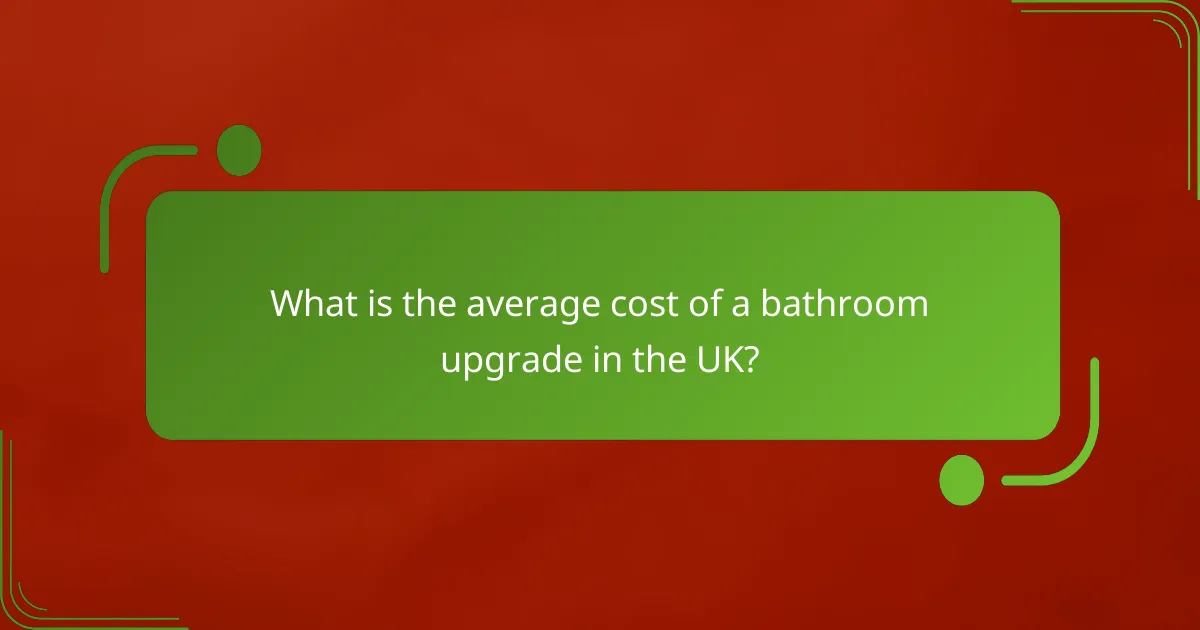Upgrading your bathroom can be a worthwhile investment, with costs typically ranging from £3,000 to £10,000 based on the scope of the project. Not only can modern fixtures lead to significant savings on energy and water bills, but they also enhance your home’s value. To manage these expenses effectively, exploring various financing strategies such as home improvement loans and government grants can provide valuable support.

What is the average cost of a bathroom upgrade in the UK?
The average cost of a bathroom upgrade in the UK typically ranges from £3,000 to £10,000, depending on the extent of the renovation and materials used. A simple refresh may be on the lower end, while a complete remodel can push costs higher.
Cost breakdown by project type
Bathroom upgrades can vary significantly based on the type of project. A basic update, such as new fixtures and paint, may cost around £1,500 to £3,000. A mid-range renovation, which includes new tiles and fittings, generally falls between £5,000 and £8,000. For a high-end remodel that involves structural changes or luxury materials, costs can exceed £10,000.
Here’s a quick breakdown of typical costs for various project types:
- Basic refresh: £1,500 – £3,000
- Mid-range renovation: £5,000 – £8,000
- High-end remodel: £10,000+
Regional cost variations
Costs for bathroom upgrades can differ across the UK due to regional labor rates and material availability. For instance, renovations in London and the South East are often more expensive, with average costs potentially 20-30% higher than in Northern England or Wales.
In urban areas, the demand for skilled labor can drive prices up, while rural regions may offer lower rates. Always consider getting multiple quotes from local contractors to gauge the market rate in your area.
Factors influencing pricing
Several factors can influence the overall cost of a bathroom upgrade. The size of the bathroom plays a significant role; larger spaces typically require more materials and labor, increasing costs. Additionally, the choice of fixtures and finishes can greatly affect the budget, with high-end products significantly raising the overall price.
Labor costs are another critical factor. Hiring experienced professionals may incur higher fees, but can lead to better quality work and fewer issues down the line. It’s essential to balance quality with budget to ensure a successful upgrade.

What are the potential savings from a bathroom upgrade?
Upgrading your bathroom can lead to significant savings in energy and water costs, as well as increase your home’s overall value. By investing in modern fixtures and energy-efficient solutions, homeowners can enjoy lower utility bills and a better return on investment when selling their property.
Energy efficiency improvements
Energy-efficient upgrades, such as LED lighting and improved insulation, can reduce electricity consumption significantly. For instance, switching to LED bulbs can cut lighting costs by up to 80% compared to traditional incandescent bulbs.
Additionally, installing energy-efficient ventilation systems can help maintain optimal temperatures, further lowering heating and cooling expenses. Homeowners should consider the initial investment versus long-term savings when selecting energy-efficient options.
Increased home value
A bathroom upgrade can enhance your home’s market value, often recouping a substantial portion of the renovation costs. On average, homeowners can expect to recover around 60-70% of their investment when selling their home after a bathroom remodel.
Modern, stylish bathrooms appeal to potential buyers, making your property more competitive in the real estate market. Focus on high-impact features like updated fixtures, new tiles, and improved layouts to maximize value.
Water-saving fixtures
Installing water-saving fixtures, such as low-flow toilets and faucets, can significantly reduce water usage and lower monthly water bills. Low-flow toilets can save an average of 1.6 gallons per flush compared to older models.
Homeowners may also consider rainwater harvesting systems or greywater recycling to further enhance water efficiency. These systems not only save money but also contribute to environmental sustainability, making them a wise investment for eco-conscious homeowners.

What financing strategies are available for bathroom upgrades?
Several financing strategies can help you manage the costs of bathroom upgrades, including home improvement loans, credit card options, and government grants. Each option has its own benefits and considerations that can impact your overall budget and repayment plans.
Home improvement loans
Home improvement loans are specifically designed for renovations and upgrades, allowing you to borrow a set amount based on your home’s equity. These loans typically offer lower interest rates compared to personal loans, making them an attractive option for larger projects.
When considering a home improvement loan, check the terms carefully. Look for fixed rates, repayment periods, and any associated fees. It’s common for these loans to range from a few thousand to tens of thousands of dollars, depending on your needs and creditworthiness.
Credit card options
Using a credit card for bathroom upgrades can be convenient, especially if you have a card with a low interest rate or a promotional 0% APR offer. This method allows for flexibility in payments, but it’s crucial to manage your spending to avoid high-interest debt.
Consider using a rewards credit card to earn points or cash back on your purchases. However, ensure you can pay off the balance before interest accrues, as credit card rates can be significantly higher than other financing options.
Government grants and incentives
Government grants and incentives can provide financial assistance for bathroom upgrades, particularly for energy-efficient improvements or accessibility modifications. These programs vary by location, so it’s essential to research what is available in your area.
Check local and federal resources for potential grants, tax credits, or rebates. For example, some programs may cover a portion of costs for installing water-saving fixtures or making your bathroom more accessible. Always verify eligibility requirements and application processes to maximize your benefits.

How can I choose the right upgrades for my bathroom?
Choosing the right upgrades for your bathroom involves assessing your needs and wants, consulting with professionals, and researching materials and fixtures. This process ensures that your upgrades are both functional and aesthetically pleasing while staying within your budget.
Prioritizing needs vs. wants
Start by identifying what upgrades are essential for your bathroom’s functionality versus those that are purely aesthetic. Needs may include fixing plumbing issues or replacing outdated fixtures, while wants could be luxury items like heated floors or high-end countertops.
Consider creating a list that categorizes your upgrades into needs and wants. This helps you allocate your budget effectively, ensuring that critical improvements are made first, while still allowing for some personal touches if funds permit.
Consulting with professionals
Engaging with professionals such as contractors or interior designers can provide valuable insights into your bathroom upgrade project. They can help you understand the feasibility of your ideas, recommend suitable materials, and ensure compliance with local building codes.
When consulting professionals, ask for multiple quotes and timelines to compare options. This not only helps you find the best price but also allows you to gauge the expertise and reliability of different contractors.
Researching materials and fixtures
Investigating various materials and fixtures is crucial for making informed decisions that align with your budget and style preferences. Look into different types of tiles, countertops, and plumbing fixtures to find options that offer durability and aesthetic appeal.
Consider the long-term costs associated with each material, such as maintenance and durability. For example, while natural stone may be more expensive upfront, it could save you money in the long run due to its longevity. Create a comparison chart to visualize the pros and cons of each option before making a final decision.

What are the most popular bathroom upgrade trends in the UK?
In the UK, popular bathroom upgrade trends focus on enhancing functionality, sustainability, and aesthetics. Homeowners are increasingly opting for smart technology, eco-friendly materials, and open-concept designs to create modern, efficient spaces.
Smart bathroom technology
Smart bathroom technology includes features like automated lighting, smart showers, and heated floors that can be controlled via smartphones or voice commands. These innovations not only improve convenience but can also enhance energy efficiency.
When considering smart upgrades, evaluate the cost versus the potential savings on utility bills. For example, smart thermostats can reduce heating costs by allowing for precise temperature control.
Eco-friendly materials
Using eco-friendly materials in bathroom upgrades involves selecting sustainable options such as bamboo flooring, recycled glass tiles, and low-flow fixtures. These choices help reduce environmental impact while promoting a healthier indoor atmosphere.
Investing in eco-friendly materials may have a higher upfront cost, but they often lead to long-term savings through reduced water and energy consumption. Look for products with certifications like FSC or Energy Star to ensure sustainability.
Open-concept designs
Open-concept designs in bathrooms create a spacious feel by removing unnecessary walls and barriers. This trend often incorporates natural light and seamless transitions between spaces, making the bathroom more inviting and functional.
To achieve an open-concept look, consider using glass partitions instead of solid walls and incorporating large mirrors to enhance light reflection. Keep in mind that this design may require careful planning to maintain privacy and functionality.

What are the common pitfalls to avoid during a bathroom upgrade?
Common pitfalls during a bathroom upgrade include underestimating costs and neglecting plumbing and electrical requirements. Avoiding these issues can save time and money while ensuring a successful renovation.
Underestimating costs
Many homeowners fail to accurately estimate the total costs involved in a bathroom upgrade. This can lead to budget overruns and financial stress. It’s essential to account for all expenses, including materials, labor, permits, and unexpected repairs.
To avoid this pitfall, create a detailed budget that includes a contingency fund of around 10-20% for unforeseen expenses. Research average costs for fixtures, tiles, and labor in your area to get a realistic picture of what to expect.
Ignoring plumbing and electrical needs
Overlooking plumbing and electrical requirements can result in significant issues during a bathroom upgrade. Proper planning is crucial to ensure that existing systems can handle new fixtures and appliances without causing problems.
Before starting your renovation, consult with professionals to assess your plumbing and electrical systems. This may involve upgrading wiring or plumbing lines, which can add to your overall costs but is necessary for safety and functionality.
